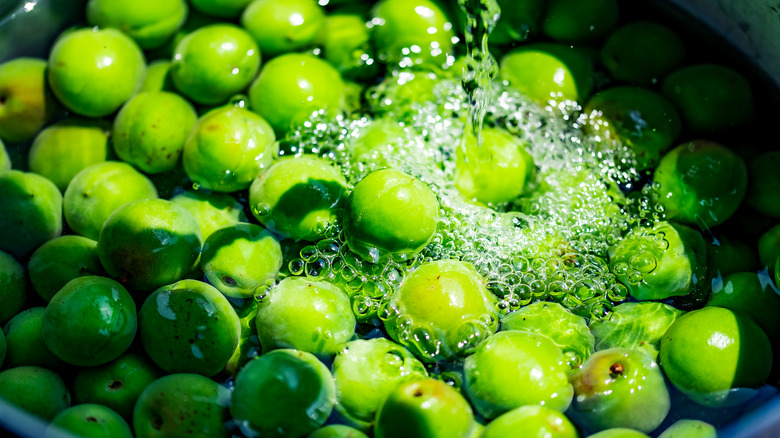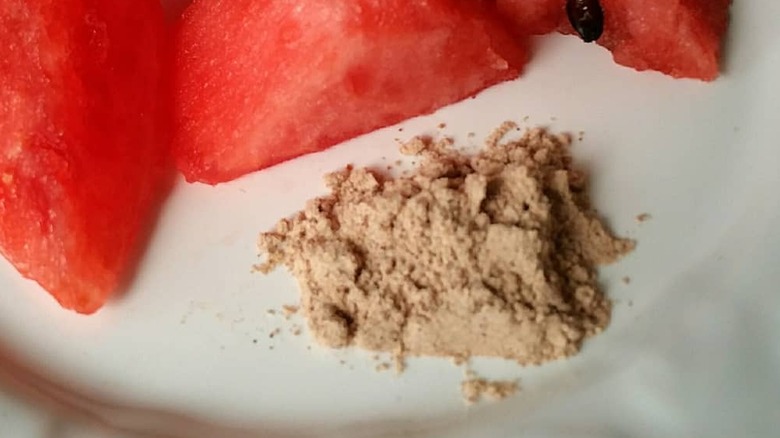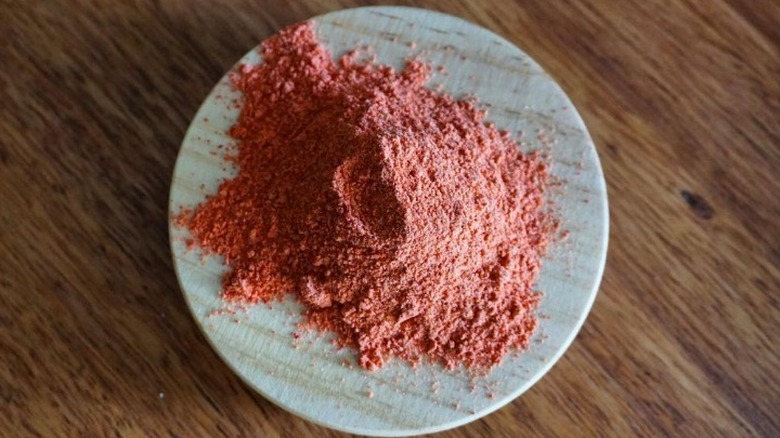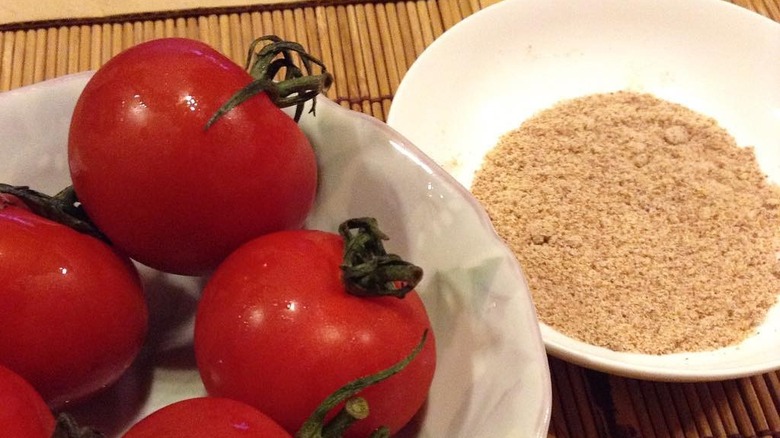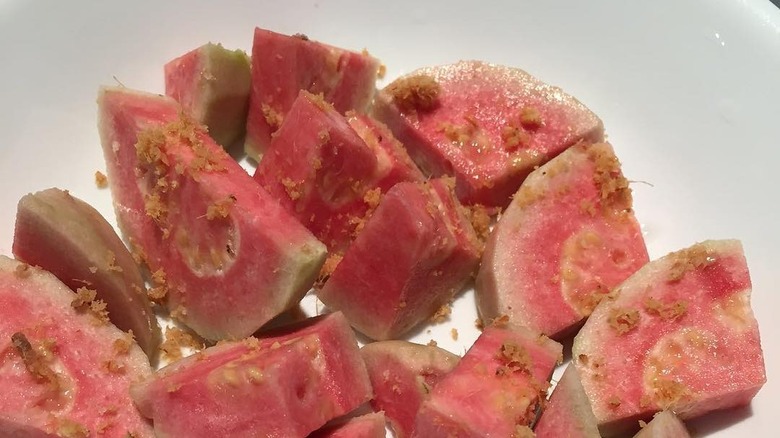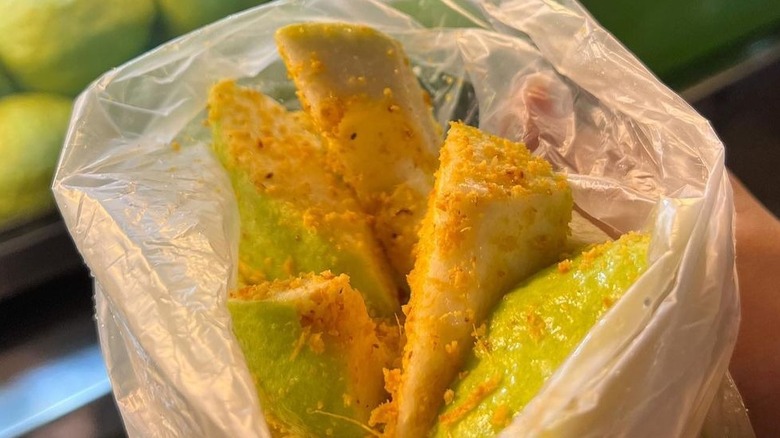Why Taiwanese Plum Powder Is A Pantry Must-Have
We enjoy plums in many different ways. When they are fresh, plums are sweet and juicy and can be eaten on their own; but if you find yourself with more than you can eat, plums can also be cooked into jams or compotes to be enjoyed at a later time.
East Asian plums are slightly different from Western plums, in that they are naturally sour. Because of that, they need to first be preserved, pickled, juiced, turned into wine, added to dishes, or made into sauces before they are consumed, per Minnepa Orchards. One of the ways the fruit is particularly enjoyed in Taiwan is as a powder, where (per Saveur) it plays supporting actor in a cast of popular street snacks ranging from savory fried potatoes to sweet, freshly cut fruit.
Taiwan plum powder is closely related to li hing mui, the bright red Hawaiian powder that is mixed into everything from cut fresh fruit to gummy bears and shaved ice, per Thrillist. While li hing mui afficionados would know that the powder likely has origins in China like its name does, and that the treat has been around since the early 20th century, less is known about "Mei zi fen" in Mandarin, or "plum powder," even on its home turf.
How plum powder is made
Taiwan Panorama says that while plums may have been grown in China for thousands of years, they didn't become part of Taiwan's agriculture landscape until the mid-1950s, when the fruit was introduced to the island. Panorama adds that most of the plum trees in Taiwan are clustered in the central region of Nantou County, and are harvested annually in April.
Taiwan food distributor Yun Hai, which commissions plum powder from a family who has made the delicacy for generations, says plum powder is made with fruit that has been kept in salt for about six months. Once that time has passed, the plums are then washed off and laid out under the sun to dry naturally for a further two months before they are finally ground into a powder. Another plum powder manufacturer says the fruit's stones are removed from the plums before they are turned into powder, per EasyMall24.
Yun Hai says its natural plum powder is made with just four ingredients: plum, salt, sugar, and licorice powder. But given that plum powder is widely distributed across the island's night markets by fresh fruit and snack vendors, we can't imagine all plum powders will be made to the same standard and purity.
Plum powder vs li hing mui powder
While Hawaii's li hing mui and Taiwan's plum powder are both made from the same fruit, manufacturers of both wouldn't be leading customers astray when they say that the products are different.
Per Snack Hawaii, li hing mui can be made with the skin of the li hing plum, which is ground into a powder and mixed in with red food coloring — which provides its distinctive color — licorice, salt, water, and vinegar. Spoon University says the powder can then be sprinkled over fresh fruit, candy, shaved ice, and toasted rice crackers, or used as a flavoring for drinks. Food52 says li hing mui also shines as an ice cream additive.
Taiwan's plum powder is not as brilliantly hued as its Hawaiian cousin, and as Yun Hai mentions, the condiment is made slightly differently, with dried whole plums, salt, sugar, and licorice. In spite of these cosmetic differences, both powders share a similar flavor profile that is salty, sour, and sweet.
What does plum powder tastes like
Even as Chinese plums are sour by nature, when they are preserved in salt, rinsed off, then dried (per Yun Hai), we can imagine that the end product of that process will have a more intense plum flavor. As such, we can expect plum powder to be reminiscent of the fruit from which it is made, and to carry the sweet, sour, and salty markers of its other ingredients when it is used as a condiment.
While it may not seem like it, plum powder has a versatile flavor profile and complements the tastes of Taiwan's popular night market dishes and other delicacies, from stewed meat, chicken nuggets and fries to fresh fruit, per Ms. Plum.
How plum powder is used
While plum powder might have first been used to spice up freshly cut fruit, the use of this popular condiment has gone beyond that in Taiwan, where Taiwan Panorama reports that plum sauce is already used to boost the flavors of roast duck, as well as fried chicken, per Taiwan Duck.
Per EasyMall24, plum powder can be served with beverages such as tomato juice and Coca-Cola, and can also be sprinkled over iced coffee. Like li hing mui, EasyMall24 adds that plum powder can be used to power up ice creams as well.
But one Taiwanese blogger on Pixstyleme dares plum powder fans to be more inventive and think outside the fruit box, because the writer has found the condiment to work well as a seasoning for savory dishes like cheese omelettes and fried rice, as an ingredient in cold noodle sauces, as well as an added ingredient for preparing vegetables like cooked bell peppers.
Where to buy plum powder
Plum powder is so widely available in Taiwan that many fresh fruit vendors are happy to give the tiny, square-shaped packets away for free, as long the quantities you ask for are reasonable, that is. Bottles of plum powder can also be found for purchase in grocery stores.
While plum powder may not be as readily available in the United States, packages of it are also available for purchase from online shops that distribute Taiwanese treats, including sites like Yun Hai. While it may not taste the same, li hing mui is also made with plums, and could be used as a substitute for plum powder in a pinch if you're having any trouble finding the latter.
Plum powder's nutrition profile
A bag of plum powder, as distributed by Top Quality Produce, indicates a serving size of two grams, with five calories per gram, zero fats, zero proteins, and one gram of carbs. But anyone who needs to watch their sodium intake may want to go easy on plum powder, since each two-gram serving contains 150 grams of sodium.
Plum powder, as it is sprinkled on freshly cut fruit like guava, has also come under some scrutiny in Taiwan too. Per CTS, a government check of some plum powder either sold in supermarkets or distributed at popular food markets contained higher levels of saccharine or other artificial sweeteners than they were meant to have — in one case, nine times the amount of saccharine allowed via local health standards.
